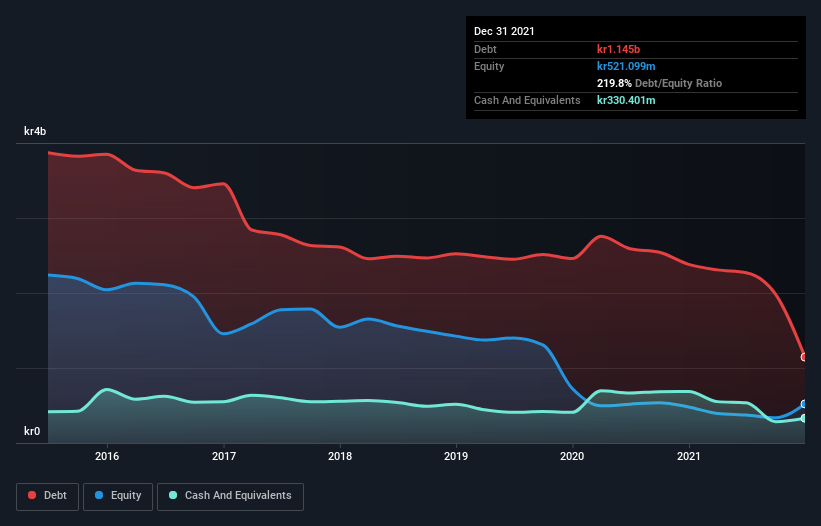The external fund manager backed by Berkshire Hathaway's Charlie Munger, Li Lu, makes no bones about it when he says 'The biggest investment risk is not the volatility of prices, but whether you will suffer a permanent loss of capital.' So it seems the smart money knows that debt - which is usually involved in bankruptcies - is a very important factor, when you assess how risky a company is. Importantly, Eidesvik Offshore ASA (OB:EIOF) does carry debt. But is this debt a concern to shareholders?
When Is Debt Dangerous?
Generally speaking, debt only becomes a real problem when a company can't easily pay it off, either by raising capital or with its own cash flow. If things get really bad, the lenders can take control of the business. While that is not too common, we often do see indebted companies permanently diluting shareholders because lenders force them to raise capital at a distressed price. Of course, debt can be an important tool in businesses, particularly capital heavy businesses. When we think about a company's use of debt, we first look at cash and debt together.
See our latest analysis for Eidesvik Offshore
How Much Debt Does Eidesvik Offshore Carry?
You can click the graphic below for the historical numbers, but it shows that Eidesvik Offshore had kr1.15b of debt in December 2021, down from kr2.38b, one year before. However, because it has a cash reserve of kr330.4m, its net debt is less, at about kr814.9m.

How Strong Is Eidesvik Offshore's Balance Sheet?
The latest balance sheet data shows that Eidesvik Offshore had liabilities of kr1.13b due within a year, and liabilities of kr1.10b falling due after that. Offsetting this, it had kr330.4m in cash and kr198.9m in receivables that were due within 12 months. So it has liabilities totalling kr1.70b more than its cash and near-term receivables, combined.
This deficit casts a shadow over the kr513.4m company, like a colossus towering over mere mortals. So we'd watch its balance sheet closely, without a doubt. At the end of the day, Eidesvik Offshore would probably need a major re-capitalization if its creditors were to demand repayment. The balance sheet is clearly the area to focus on when you are analysing debt. But you can't view debt in total isolation; since Eidesvik Offshore will need earnings to service that debt. So if you're keen to discover more about its earnings, it might be worth checking out this graph of its long term earnings trend.
In the last year Eidesvik Offshore wasn't profitable at an EBIT level, but managed to grow its revenue by 12%, to kr569m. We usually like to see faster growth from unprofitable companies, but each to their own.
Caveat Emptor
Over the last twelve months Eidesvik Offshore produced an earnings before interest and tax (EBIT) loss. Indeed, it lost kr48m at the EBIT level. If you consider the significant liabilities mentioned above, we are extremely wary of this investment. Of course, it may be able to improve its situation with a bit of luck and good execution. But we think that is unlikely since it is low on liquid assets, and made a loss of kr16m in the last year. So while it's not wise to assume the company will fail, we do think it's risky. The balance sheet is clearly the area to focus on when you are analysing debt. However, not all investment risk resides within the balance sheet - far from it. For example - Eidesvik Offshore has 2 warning signs we think you should be aware of.
If, after all that, you're more interested in a fast growing company with a rock-solid balance sheet, then check out our list of net cash growth stocks without delay.
Valuation is complex, but we're here to simplify it.
Discover if Eidesvik Offshore might be undervalued or overvalued with our detailed analysis, featuring fair value estimates, potential risks, dividends, insider trades, and its financial condition.
Access Free AnalysisHave feedback on this article? Concerned about the content? Get in touch with us directly. Alternatively, email editorial-team (at) simplywallst.com.
This article by Simply Wall St is general in nature. We provide commentary based on historical data and analyst forecasts only using an unbiased methodology and our articles are not intended to be financial advice. It does not constitute a recommendation to buy or sell any stock, and does not take account of your objectives, or your financial situation. We aim to bring you long-term focused analysis driven by fundamental data. Note that our analysis may not factor in the latest price-sensitive company announcements or qualitative material. Simply Wall St has no position in any stocks mentioned.
About OB:EIOF
Eidesvik Offshore
Provides services to the offshore supply, subsea, and offshore wind market in Norway.
Excellent balance sheet with questionable track record.
Similar Companies
Market Insights
Community Narratives





